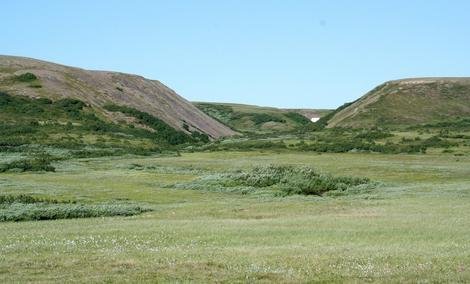Foothills of the Polar Ural mountains on the southern Yamal Peninsula in West Siberia, Russia: willow thickets have a greyish metallic canopy and stand out in the forefront and background, located mostly in concave areas. Alder, with a dark green canopy, stands out clearly against both willow and the other tundra vegetation. Credit: BC Forbes.
OXFORD, England, June 5 (UPI) -- Warming climate has turned some areas of arctic tundra into forests and if those areas grow they could accelerate global warming, European scientists say.
The advance of forest into arctic tundra could increase warming in the region by an extra 2 to 4 degrees Fahrenheit by the late 21st Century as the change from shrubs to forest alters the albedo effect, the amount of sunlight reflected by the surface of the Earth, researchers said.
In the Arctic spring and autumn, shrubs are covered under a blanket of white, light-reflecting snow, whereas trees are tall enough to rise above the snowfall, presenting a dark, light-absorbing surface, they said.
This increased absorption of the sun's radiation adds to global warming.
Scientists from Finland and Oxford University in Britain investigated an area of around 40,000 square miles stretching from western Siberia to Finland and found in 8 percent to 15 percent of the area willow and alder plants have grown into trees over 6 feet tall in the last 30 to 40 years.
"It's a big surprise that these plants are reacting in this way," Oxford researcher Marc Macias-Fauria said.
"Previously people had thought that the tundra might be colonized by trees from the boreal forest to the south as the arctic climate warms, a process that would take centuries. But what we've found is that the shrubs that are already there are transforming into trees in just a few decades."
The research has been published in the journal Nature Climate Change.















